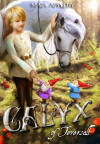Calyx of Teversall
Calyx of Teversall will entice you from the first sentence to the very last. Maia Appleby’s prose ensnares the reader in a fictional world that is both interesting and realistic at the same time. She plays off of what the young reader is already familiar with in order to structure this fantasy world full of gnomes and elves. In the beginning, we learn that Sigrid is recently widowed and struggling to make ends meet. Her husband maintained a wheat field that she now undertakes, and her three-year-old son Charlie braids the wheat. When Fenbeck, secretly a Borgh Elf, arrives and strikes a deal, Sigrid has no choice but to accept. Fenbeck magically turns many times the normal crop yield and accepts no payment but asserts that Charlie must work for him when he turns nine for one year.
Calyx of Teversall will entice you from the first sentence to the very last. Maia Appleby’s prose ensnares the reader in a fictional world that is both interesting and realistic at the same time. She plays off of what the young reader is already familiar with in order to structure this fantasy world full of gnomes and elves. In the beginning, we learn that Sigrid is recently widowed and struggling to make ends meet. Her husband maintained a wheat field that she now undertakes, and her three-year-old son Charlie braids the wheat. When Fenbeck, secretly a Borgh Elf, arrives and strikes a deal, Sigrid has no choice but to accept. Fenbeck magically turns many times the normal crop yield and accepts no payment but asserts that Charlie must work for him when he turns nine for one year.
Appleby weaves a stunning story that hooks the reader immediately and refuses to let go. She describes beings and setting so accurately that the reader doesn’t even question their existence. For example, Appleby defines her own version of fairies as soon as they are introduced in the story:
Most people—if they believe in fairies at all—think that there is one type of creature called fairy, but that couldn’t be further from the truth. Each forest throughout the land has its own unique population of fairies, and it is rare to find a forest without such magical beings. The enchanted little societies keep to themselves, for the most part, and each civilization has, above all, its own set of rules.
Sigrid and Charlie are forced to reinvent themselves to escape Fenbeck. This is how Calyx is born, the pseudonym Charlie chooses for himself as he moves to Teversall with a much better-off aunt and uncle. He learns a new way of life and becomes an expert trader under the kind guidance of his uncle, Tyrone.
The author provides readers new experiences as Calyx discovers them himself. Instead of boring prose that has to catch us up on this fantasy setting, we learn alongside of the protagonist, which makes the story much more interesting and relatable:
As he stepped in, Calyx saw a gnome-sized chair and a table holding a machine topped with two tiny wheels that were turned sideways and positioned side by side. Beside that was another table holding the device with several vertically-arranged wheels of stone in different sizes and thicknesses. Calyx gaped at the contraptions that looked nothing like the imperfectly welded, hammered-metal machinery that he was used to seeing. Not only were gnomes outstanding craftspeople, they were also brilliant inventors. Teaching a human how to use those machines seemed futile to him, as nothing like that existed in Teversall. Yet he was dying to learn.
Although Calyx begins the story as a child, we see him develop into a responsible young man. This novel acts as a bildungsroman despite being set in a fantasy world. We experience Calyx’s awe at the gnomes’ superior skills and learn how they developed these skills together with him. It is always appealing when good triumphs over evil; however, when we learn Fenbeck’s true motivations and intentions it makes our skin crawl with anticipation.
Though intended for ages eight and up, I highly recommend this novel to people of all ages and thoroughly enjoyed reading it.





